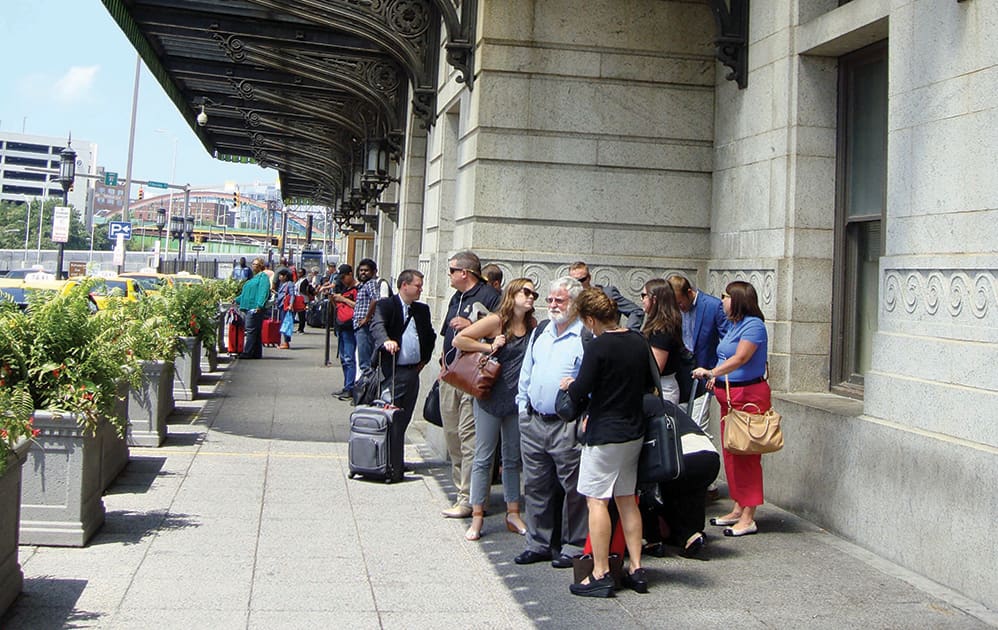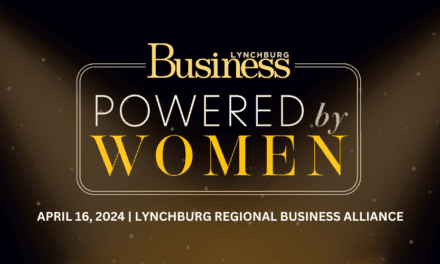Local Group Travels to Gain Insight for Tech Startups
This past August, a group traveled from Lynchburg to Baltimore to see what kinds of resources are available to entrepreneurs in that area and to ultimately see if similar initiatives could be incorporated in Central Virginia.
During the two-day trip, which was organized by the Lynchburg Regional Business Alliance (LRBA) and its Technology Council, local business leaders and other stakeholders in the area’s entrepreneurial ecosystem visited business incubators, accelerators and co-working spaces in and around Baltimore.
“It’s almost a best practice now, to seek out communities that have done initiatives there…and ‘get their story,’ so to speak,” Christine Kennedy, the Alliance’s chief operating officer and executive vice president, said.
It’s not that there aren’t resources for entrepreneurs in the Lynchburg area. There are—among them the co-working spaces Momentum, Toolry and Vector Space; the Business Development Centre on Mill Ridge Road; the Small Business Development Center on the campus of Central Virginia Community College; and the Lynchburg Office of Economic Development, which offers a nine-week class for entrepreneurs called CO.STARTERS.
There’s also the Young Entrepreneurs Academy for teenagers, offered by Leadership Lynchburg.
“There are pieces of that here but not a cohesive system of resources,” Kennedy said, prior to the trip. “If you need non-traditional financing, it’s not here. Venture capitalist funds? Practically non-existent. Can we take their example [in Baltimore] and fill the gaps here in Lynchburg?”
Some of those gaps might be filled at the Alliance’s new headquarters, which will be located in the former James River Conference Center on Church Street. Renovations to the 8,000-square-foot building are currently in the early design stages and work is expected to be completed sometime in 2017.
Anna Bentson, assistant director of the Lynchburg Office of Economic Development, called the Alliance’s move from Memorial Avenue to Church Street the “impetus behind the trip.”
“They’re going to have this space,” she said. “How do we maximize the effectiveness of this space? Is there something we can do to offer more? Classes? Accelerators? We could teach CO.STARTERS in that place. … We have all the right ingredients. It’s just figuring out how they go together.”
In Maryland, the Lynchburg delegation visited four facilities that cater to entrepreneurs: ETC (Emerging Technology Centers), the Maryland Technology Development Corporation (TEDCO), and two University of Maryland initiatives, the Maryland Technology Enterprise Institute (Mtech) and the Maryland International Incubator.
Collectively, these organizations offer accelerators—short-term programs that jumpstart businesses with access to mentors and seed money—and incubators, where a startup might spend a year or two developing its product and growing its business without the hassle and expense of having its own facility.
There also are co-working spaces, where freelancers and early stage entrepreneurs pay a monthly fee for desk space and other amenities, such as communal kitchens, conference rooms, workout gyms and showers.
In addition to touring the facilities, the delegation met with senior staff, who talked about their individual programs and offered advice. Regarding target market, one of the things the group was asked to think about during the trip, Deb Tillett, executive director of ETC, suggested Lynchburg “start small and engineer success.”
“If there’s something Lynchburg is known for, think of that,” she said. “Work on a budget you think is meaningful until you prove yourself. You have to really engineer success.”
Neil Davis, director of entrepreneurial initiatives at TEDCO, had similar advice. “Pick something that aligns with your embedded strengths and then craft a program [in line with] those strengths,” he said. “What problems are you having? Wrap an accelerator around it to solve it.”
That advice stuck with several people who made the trip, among them Nathan Kolb, director of the Small Business Development Center at CVCC. He said that while most entrepreneurial initiatives are focused on the tech industry, people have to be open to the idea that other markets might make more sense for the Lynchburg area.
“We don’t have to figure it out,” Kolb said, adding that Lynchburg’s target market might be agriculture, transportation or even aerospace. “NASA’s not that far away. We just have to stand back and let what’s already happening tell us, and we have to be willing to do that.”
Bentson had similar thoughts. She said the entrepreneurs that Economic Development works with in their CO.STARTERS program are mostly “lifestyle oriented”—more likely to be a coffee shop or restaurant than a tech startup.
“We need to get together and throw everything up on a white board and find out where the gaps are,” Bentson said.
While touring the University of Maryland programs, Mtech and the Maryland International Incubator, the delegation learned more about the role big research universities can play in the entrepreneurial ecosystem.
Mtech has a student business incubator—the “Startup Shell”—which is, according to Mtech’s director, Peter Sandborn, “100-percent student run.” Thirty companies operate out of the incubator, which is managed and funded by students. The facility also has a roomful of MakerBot 3D printers.
The Maryland International Incubator operates in an office building just outside the UM campus. Over the past five years, 30 companies from all over the world—China, Italy, Israel, India, South Korea and others—have graduated from the program. Some have remained in the area.
The international companies also hire UM students and take advantage of the university’s research facilities.
Dennis Jarvis, director of economic development for the Town of Altavista, said he’d like to see Lynchburg’s region expand to include Virginia Tech, the University of Virginia and the Institute for Advanced Learning and Research in Danville.
“We’re going to have to redefine the region if we’re going to do something,” Jarvis said. “We have a good nucleus of higher education [in Lynchburg], but we don’t have a research and development university here.”
Prior to the trip, the delegation also was asked to think about “exportable features,” things they saw in Maryland “that are applicable to the LRBA and our region.”
Asked about that later, Bentson said something she thinks could be created soon in the Lynchburg area, even before making decisions about things like target market, is more co-working space.
“That’s something we could do pretty quickly, without choosing your sectors—more opportunities for people to work together and for those creative collisions to happen,” she said. “That’s really what you’re doing, putting creative people in the same room together. Even if they’re working on entirely different things they might generate new ideas together.”
Asked what he’d like to see happen, Kolb said, “There were two things that I saw and that I think could be incorporated quickly into this area, the first of which is a coordinated ecosystem. Everywhere we went—TEDCO, University of Maryland, ETC—everybody knew about each other and worked with each other.
“They didn’t just know who they were, but coordinated in dealings with each other and…knew it would work best together. I want to see that. I want the Small Business Development Center to help foster that in our region with entrepreneurial development.”
Kolb also said he’d like to see entrepreneurs have access to what he described as a “full complement of business services,” including workspace, mentors, funding, advisors and other entrepreneurs.
He’d like to see these services available to entrepreneurs throughout the region, regardless of whether they’re associated with a business incubator or a particular organization, or live within a certain area.
“Anywhere in the region, you could go to one spot to understand what you needed to do as an entrepreneur,” he said. “They have that [in Baltimore] in various ways. That’s a good thing we can accomplish here in the short term in this region.”
Copy and photos by Suzanne Ramsey








